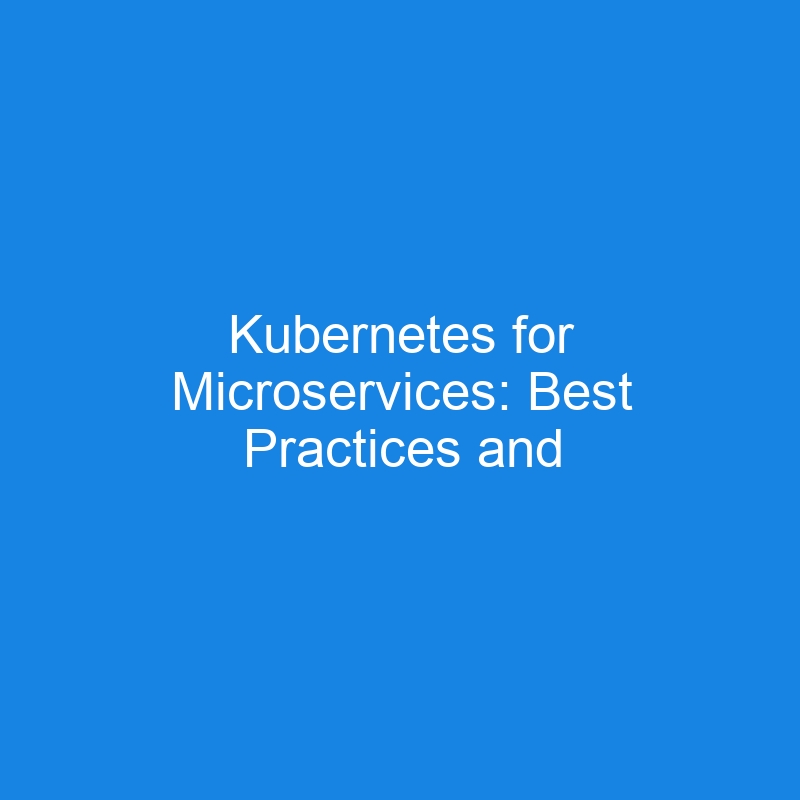In modern software development, microservices architecture has revolutionized how we build and deploy applications. Its a design paradigm that structures applications as collections of loosely coupled services. Kubernetes an open-source container orchestration platform, has become the go-to solution for deploying and managing microservices efficiently.
Kubernetes excels in handling microservices because it simplifies scaling, monitoring, and managing application lifecycles. This blog explores Kubernetes concepts, best practices, design patterns, and real-world implementations that make it an ideal platform for microservices.
Core Kubernetes Concepts for Microservices
Pods and Containers
In Kubernetes, pods are the smallest deployable units that can contain one or more tightly coupled containers. Each pod shares a network namespace, making it ideal for running microservices that require close communication.
Example: For an e-commerce application, a pod may host a product service container alongside a logging container.
apiVersion: apps/v1
kind: Deployment
metadata:
name: product-service
spec:
replicas: 3
selector:
matchLabels:
app: product-service
template:
metadata:
labels:
app: product-service
spec:
containers:
- name: product-service
image: ecommerce/product-service:1.0
ports:
- containerPort: 8080
Services and Networking
Services in Kubernetes provide stable networking endpoints to expose pods to other pods or external traffic. Key types include:
- ClusterIP: For internal communication within the cluster.
- NodePort: Exposes a service on each node’s IP.
- LoadBalancer: Integrates with cloud providers to route external traffic.
Example: A front-end service can use a LoadBalancer to route traffic to a back-end microservice.
apiVersion: v1
kind: Service
metadata:
name: product-service
spec:
selector:
app: product-service
ports:
- port: 80
targetPort: 8080
type: ClusterIP
ConfigMaps and Secrets
ConfigMaps store configuration data, while Secrets handle sensitive information like API keys or passwords. They decouple application logic from configuration, enhancing portability.
Example: A payment service can reference a Secret to access payment gateway credentials securely.
apiVersion: v1
kind: ConfigMap
metadata:
name: product-service-config
data:
DATABASE_URL: "mongodb://db:27017/products"
CACHE_TTL: "3600"
Secrets:
apiVersion: v1
kind: Secret
metadata:
name: product-service-secrets
type: Opaque
data:
DB_PASSWORD: <base64-encoded-password>
API_KEY: <base64-encoded-key>
Best Practices for Microservices on Kubernetes
Service Discovery and Load Balancing
Kubernetes automatically handles service discovery and load balancing. Tools like CoreDNS enable dynamic resolution of services by name.
Example: A user authentication service can be discovered by other services through DNS without hardcoding IP addresses.
Configuration Management
Follow these configuration best practices:
- Externalize all environment-specific configurations
- Use ConfigMaps for non-sensitive data
- Implement Secrets for sensitive information
- Version your configurations alongside your application code
Tip: Use version-controlled configuration files for better traceability.
Resource Management
Define resource requests and limits for CPU and memory to prevent resource contention and ensure optimal utilization.
Example: A product catalog service might request 500m CPU and 512Mi memory to operate efficiently.
resources:
requests:
memory: "256Mi"
cpu: "200m"
limits:
memory: "512Mi"
cpu: "500m"
Monitoring and Logging
Monitoring and logging are essential for maintaining microservices. Integrate tools like Prometheus and Grafana for metrics, and use EFK Stack (Elasticsearch, Fluentd, Kibana) for centralized logging.
Example: Monitor database query latency to optimize performance in a search service.
For standardized logging, use JSON format with correlation IDs:
log.info("Processing order", {
"requestId": "123e4567-e89b",
"orderId": "ORD-001",
"customer": "john.doe"
});
Design Patterns
Sidecar Pattern
The sidecar pattern involves deploying a helper container alongside the main application container within the same pod.
Example: Use a sidecar container for logging or proxying HTTP traffic.
spec:
containers:
- name: product-service
image: ecommerce/product-service:1.0
- name: log-aggregator
image: logging/aggregator:1.0
Ambassador Pattern
The ambassador pattern uses a proxy container to handle network requests on behalf of the main application.
Example: Implement an API gateway for routing external requests to the appropriate microservice.
spec:
containers:
- name: product-service
image: ecommerce/product-service:1.0
- name: redis-ambassador
image: ambassador/redis:1.0
Service Mesh Implementation
A service mesh like Istio or Linkerd provides advanced networking capabilities, such as traffic management, security, and observability.
Example: Secure inter-service communication using mutual TLS in a financial application.
Real-world Examples and Implementation
E-commerce Application Example
Imagine an e-commerce platform built with microservices: user authentication, product catalog, and order processing services. Kubernetes enables:
- Dynamic scaling: Scale the product catalog service during peak shopping seasons.
- Resilience: Handle failures using readiness and liveness probes.
apiVersion: apps/v1
kind: Deployment
metadata:
name: order-service
spec:
replicas: 3
template:
spec:
containers:
- name: order-service
image: ecommerce/order-service:1.0
ports:
- containerPort: 8080
livenessProbe:
httpGet:
path: /health
port: 8080
readinessProbe:
httpGet:
path: /ready
port: 8080
env:
- name: DB_URL
valueFrom:
configMapKeyRef:
name: order-service-config
key: DATABASE_URL
Deployment Strategies
- Blue-Green Deployments: Deploy a new version alongside the old one and switch traffic once validated.
- Canary Deployments: Gradually roll out updates to a small percentage of users before full deployment.
Example: Update the payment service to a new version using canary deployments to minimize risk.
spec:
strategy:
type: RollingUpdate
rollingUpdate:
maxSurge: 1
maxUnavailable: 0
Conclusion and Next Steps
Kubernetes is a powerful platform for building and managing microservices, offering features that simplify deployment, scalability, and maintenance. By leveraging best practices and design patterns, you can create robust, efficient, and scalable systems.
Next Steps:
- Explore tools like Helm for managing Kubernetes applications.
- Learn about advanced Kubernetes topics such as RBAC and network policies.
- Experiment with service mesh implementations like Istio for better observability and traffic control.
Remember that these patterns should be adapted to your specific use case and organizational needs. Start small, monitor carefully, and scale as needed.
By following these best practices and patterns, you’ll be well-equipped to build and maintain a robust microservices architecture on Kubernetes.
If you found this helpful, consider following us here on dev.to for more content about Kubernetes, microservices, and cloud-native development. Feel free to share this post with your team or anyone who might find it valuable.
Happy coding! 🚀
